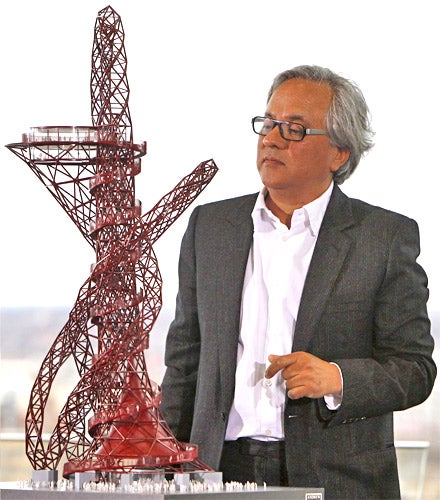Kapoor told to take his Olympic tower back to drawing board

It has been nicknamed the "hubble bubble" tower and its creators hope that the soaring structure will provide a lasting legacy for east London once the Olympic Games are over. But unless they remember to install pipes for the toilets, Anish Kapoor's shisha pipe-shaped Olympic tower may never get off the ground.
A review of the tower's design by the Government's architecture watchdog has found that the 114-metre artwork still has a long way to go before it can convince planning chiefs that the £19.1m project will do what it set out to do.
The Commission for Architecture and the Built Environment (Cabe), which advises the Government on architecture and urban planning, published a review yesterday concluding that the sculpture's design is "not yet resolved in sufficient detail to receive planning approval".
Its panel of experts say a series of issues have been overlooked in the tower's structure, including how sewage pipes will be incorporated without compromising the overall aesthetics of Anish Kapoor and Cecil Balmond's design.
The tower, which goes by the official name of ArcelorMittal Orbit, is expected to become Britain's tallest public artwork and will enable hundreds of visitors every day to take in sweeping panoramas of the Olympic Park and London skyline. It will be one of the first buildings visitors encounter when they come through the entrance of the Olympic Park and stands close to the Olympic stadium.
Funded by a £16m donation from steel billionaire Lakshmi Mittal, Britain's richest man, the tower is intended to be a lasting legacy for the area, encouraging tourists to return to Stratford long after the 2012 games have come to a close.
But Cabe's four-page critique has concluded that further work is required on the design of the entrance pavilion and power supply unit, as well as the tower's two viewing platforms, two lifts, stairs and the way it integrates with the wider Olympic park.
In particular, the report's authors said more thought needed to paid to the ancillary buildings around the tower, where security checks and ticket sales will be carried out.
"There is a danger that such mundane requirements will downgrade the quality of the Orbit as an art work," the report stated. "Without these details being submitted as part of the planning submission, we, and the planning authority, are being asked to take on trust that they will be elegantly resolved."
There are also concerns that despite the tower's height, it could still be overshadowed by the cauldron which will hold the Olympic flame throughout the tournament. The current planning application for the Olympic Cauldron, which will also be adjacent to the main stadium, is a large concrete structure up to 150 metres high, taller than the Orbit tower.
"This would call into question both the location for the Orbit and its height, if a second tall structure were constructed in such close proximity," the report found.
Cabe's findings are significant because the construction of the tower is already on a tight deadline. Arcelor Mittal, the steel company building the tower, hopes to have the red structure completed by December 2011 but much of that will depend on whether they get swift planning approval.
A spokesperson for the company yesterday played down Cabe's findings and said their concerns are all part of the public consultation process that precedes planning permission. "The questions they posed have been addressed, and this type of analysis is typical in the development of a project on this scale," the spokesperson said. "A public consultation on the project is underway, and this feedback is central to the process."
When it is finished, the tower will have two viewing platforms for both the public and private functions. Access to the platforms will be via two high speed lifts that will be able to transport more than 600 visitors a day.
Able-bodied guests will then have to descend through a spiral staircase that clings to the side of the structure.
Turner winner Kapoor beat competition from the artist Antony Gormley and the architects Caruso St John to win a contest by Mayor of London Boris Johnson to find an "iconic symbol" for the city and the Olympic Park.
Mr Johnson hopes that the tower, which some have likened to a mangled rollercoaster, will be an architectural triumph in the mould of the Eiffel Tower in Paris and the Statue of Liberty in New York.
The Orbit is just the latest example of the current vogue for enormous – and costly – works of public art such as Anthony Gormley's Angel of the North and the 50m-tall horse by Mark Wallinger which will soon greet Eurostar passengers shooting through the Kent countryside.
Despite its criticisms, Cabe praised Kapoor's design for its sustainability. The Orbit will be constructed from 60 per cent recycled steel, with 25 per cent of concrete from recycled sources, and 75 per cent of bulk materials other than steel transported to site by rail.
Join our commenting forum
Join thought-provoking conversations, follow other Independent readers and see their replies
Comments